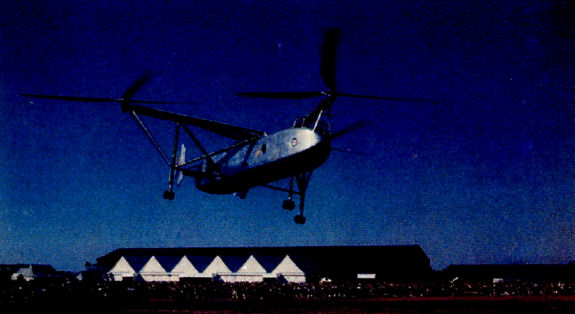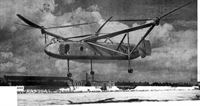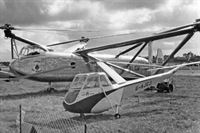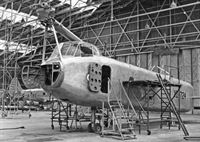
Описание
Страна : Великобритания
Год : 1948
Вертолет
Многоцелевой тяжелый вертолет с экипажем из двух-трех человек
Cierva W.11 Air Horse
7 декабря 1948 года впервые взлетел самый крупный в мире на тот момент вертолет Cierva W.11 Air Horse. В его фюзеляже стоял мотор Merlin с приводами на три больших трехлопастных несущих винта, установленных на консольных балках, выдающихся вперед и в стороны из фюзеляжа прямоугольного сечения.
В пассажирской версии W.11 мог перевозить 24 человека. Также предусматривалась работа в качестве скорой помощи, воздушного крана и распылителя химических реагентов в сельском хозяйстве. В июле 1946 года фирме "Cierva" поручили разработать один вертолет W.11, второй заказали в начале 1947 года.
С грузом в 3048 кг инсектицидов вертолет W.11 оказался довольно удачным летательным аппаратом для опыления полей. Проведенные после первого полета испытания показали многообещающие результаты. Министерство по делам колоний выделило дотацию в 45 000 фунтов для содействия в модернизации, так как предлагаемая модель в перспективе должна была использоваться за границей для обработки полей. 13 июня 1950 года, незадолго до полета второго прототипа, первый W.11 разбился, погиб весь экипаж в составе трех летчиков-испытателей. Второй прототип W.11 так и не взлетел, и пошел на слом в 1960 году. Обозначение W.11Т дали доработанному проекту W. 11 с двумя моторами Rolls-Royce Merlin 502 мощностью 1620 л. с. (1208 кВт). W.12 был проектом грузовой машины с турбовинтовыми двигателями Rolls-Royce Dart. Ни один из этих проектов не осуществился, так как к тому времени фирма "Cierva", пропустив проект W.13, включилась в разработку проекта W.14, ставшего машиной Skeeter и построенного фирмой "Saunders-Roe Ltd."
ТАКТИКО-ТЕХНИЧЕСКИЕ ХАРАКТЕРИСТИКИ
Cierva W.11 Air Horse
Тип: многоцелевой тяжелый вертолет с экипажем из двух-трех человек
Силовая установка: V-образный поршневой мотор Rolls-Royce Merlin 24 мощностью 1620 л. с. (1208 кВт)
Летные характеристики: максимальная скорость 225 км/ч на оптимальной высоте; крейсерская скорость 153 км/ч на оптимальной высоте, практический потолок 8535 м; дальность полета 531 км
Масса: пустого вертолета 5507 кг; максимальная взлетная 7938 кг
Размеры: диаметр каждого несущего винта 14,33 м; общая ширина с вращающимися несущими винтами 28,96 м; длина с вращающимися несущими винтами 27,00 м; высота 5,41 м; общая ометаемая площадь 483,53 м2
Полезная нагрузка: см. выше
- Описание
Фотографии
-
Мировая Авиация 90
Вертолет "Air Horse" имел два киля на законцовках стабилизатора и кабину для экипажа из трех человек. Общие расходы Министерства поставок на разработку этого проекта оценивались в 350000 фунтов стерлингов
-
Aeroplane Monthly 1978-01 / E.Rees - Cierva's triple rotor chopper
Регистрационный номер: VZ724 [16], G-ALCV [16] VZ724 performing at Farnborough in 1949, the fin area having been increased by the addition of fore and aft extensions.
-
Aeroplane Monthly 1990-06 / J.Yoxall - H.A.Marsh /They who dared first/ (2)
Регистрационный номер: VZ724 [16], G-ALCV [16] VZ724 airborne at Eastleigh Airport, displaying its original tail-fins and the long-stroke undercarriage. The outriggers have already been modified.
The triple-rotor Cierva W-11 Air Horse. Two were built and Marsh was killed in VZ724 on June 14, 1950 while flying as a passenger during an RAF evaluation flight.
Cierva’s ungainly Air Horse was the world’s largest helicopter when it appeared shortly after the war, but the fatal crash of one of the two prototypes ended the programme. -
Aeroplane Monthly 1978-01 / E.Rees - Cierva's triple rotor chopper
Регистрационный номер: VZ724 [16], G-ALCV [16] After its 1949 Farnborough appearance VZ724 began flight trials at maximum weight, flying at 17,500lb AUW on October 12.
-
OS 1 / H.Cowin - X-Planes
Регистрационный номер: VZ724 [16], G-ALCV [16] The huge three rotored Cierva W.11 Air Horse was conceived towards the end of World War II and VZ 724 seen here, the first of two ordered, made its maiden flight on December 8th, 1948. Developed to meet a need for a heavy-lift helicopter capable of hauling a 5,000lb payload, the W.11 was powered by a single 1. 620hp Rolls-Royce Merlin 32 that drove a unique three rotor system. Tragically, VZ 724 was to suffer a catastrophic in-flight failure, commencing in the forward rotor hub, but leading to the disintegration of the starboard rear-rotor support structure. All three crew members, Sqn. Ldr. F.J. 'Jeep' Cable, co-pilot Alan Marsh and flight test observer H.J. Unsworth, losing their lives in the ensuing crash. The second W.11, WA 555, is believed to have been flight tested briefly, but only close to the ground and as part of the investigation into the loss of the first machine.
-
Aeroplane Monthly 1988-09 / Farnborough 1949
Регистрационный номер: VZ724 [16], G-ALCV [16] Easily the most unorthodox shape at the show was Cierva Air Horse VZ724, flown in from Eastleigh by Alan Marsh. Although it had been displayed in the static park the previous year, this was the first time the Farnborough crowds had seen it fly: it created quite a stir with its towering structure and majestic progress. The Air Horse's three 47ft-diameter rotors were driven by a single Rolls-Royce Merlin 24. All-up weight was 7,500lb.
-
Aviation Historian 32 / N.Stroud - Tuesday the 13th
Регистрационный номер: VZ724 [16], G-ALCV [16] By this time fitted with fins of increased area, VZ724 clatters overhead during a flight in 1949, possibly at that year’s SBAC show, at which it performed a memorable flying display. The fins never incorporated rudders, yaw control being effected by means of fore-and-aft cyclic-pitch variation applied differentially to the rear rotors.
-
Aviation Historian 32 / N.Stroud - Tuesday the 13th
Регистрационный номер: VZ724 [16], G-ALCV [16] Rotary-wing Cerberus - the Air Horse remains the only helicopter to fly with three rotor-heads. The prototype, VZ724, is seen here during one of the public displays it made after its first free flight on December 8, 1948. Note the open door to aid cooling of the single horizontally-mounted Merlin engine
-
Aeroplane Monthly 1978-01 / E.Rees - Cierva's triple rotor chopper
Регистрационный номер: VZ724 [16], G-ALCV [16] -
Aeroplane Monthly 1982-09 / ??? - Vintage Farnboroughs
Регистрационный номер: VZ724 [16], G-ALCV [16] The Merlin-powered Cierva Air Horse VZ724 demonstrated at the 1949 Farnborough. The forward door had to be kept open to assist engine cooling.
-
Air Enthusiast 2003-01 / K.Wixey - The Bolas touch
Регистрационный номер: G-ALCV [16], VZ724 [16] Harold Bolas was greatly involved with development of the Cierva W.11 Air Horse. The prototype was VZ724 (later G-ALCV), here at Eastleigh in 1948.
-
Aeroplane Monthly 1998-10 / M.Hooks - Farnborough 50th
Регистрационный номер: G-ALCV [16], VZ724 [16] Cierva’s massive and outlandish Air Horse helicopter was powered by a single Rolls-Royce Merlin driving the three rotors. Appearing in 1948 and 1949, it was abandoned following the crash of the first of two prototypes in June 1950.
-
Aeroplane Monthly 1978-01 / E.Rees - Cierva's triple rotor chopper
Регистрационный номер: VZ724 [16], WA555 [2], G-ALCV [16] Both machines at Eastleigh early in 1950, when WA555 was at the ground running stage.
-
Авиация и Космонавтика 2008-01 / Е.Ружицкий - История вертолетных рекордов (3)
Регистрационный номер: VZ724 [16], G-ALCV [16] Демонстрация вертолета W-11 "Эр Хорс" на выставке в Фарнборо
-
Aviation Historian 32 / N.Stroud - Tuesday the 13th
Регистрационный номер: G-ALCV [16], VZ724 [16] The first Air Horse, VZ724, made its public debut at the 1948 SBAC show at Farnborough that September, a month before it began its ground running and tethered hovering trials, and three months before its first free flight. Fitted with its original small fins, it wears its civil registration, G-ALCV, allocated during August-October 1948.
-
Aviation Historian 32 / N.Stroud - Tuesday the 13th
Регистрационный номер: G-ALCV [16], VZ724 [16] Little and large - another photograph of the prototype Air Horse at the 1948 SBAC show, alongside G-AJCJ, the prototype of its diminutive stablemate, the Cierva W.14 Skeeter, which made the type’s maiden flight at Eastleigh the following month. The Skeeter went on to be developed and built in numbers by Saunders-Roe.
Другие самолёты на фотографии: Cierva/Saunders-Roe W.14 Skeeter - Великобритания - 1948
-
Aeroplane Monthly 1978-01 / E.Rees - Cierva's triple rotor chopper
A rear view, showing the spacious interior. The original configuration of the outrigger booms is also shown.
-
Aeroplane Monthly 1978-01 / E.Rees - Cierva's triple rotor chopper
Регистрационный номер: WA555 [2] The second Air Horse, WA555, at Eastleigh in July/August 1950 after reassembly following accident investigations. A prototype Skeeter is on the left.
Другие самолёты на фотографии: Cierva/Saunders-Roe W.14 Skeeter - Великобритания - 1948
-
Aviation Historian 32 / N.Stroud - Tuesday the 13th
Регистрационный номер: VZ724 [16], G-ALCV [16] With the second of the two Cunliffe-Owen Concordias, G-AKBE, in the background, work progresses on the first W.11 Air Horse prototype, VZ724, at Eastleigh in the spring of 1949. The extreme nose of the Air Horse’s fuselage could be opened, as seen here, to give access to the rear of the instrument panel and pilot’s controls.
Другие самолёты на фотографии: Cunliffe-Owen Concordia - Великобритания - 1947
-
Aviation Historian 32 / N.Stroud - Tuesday the 13th
Before the Air Horse came the ‘‘Spraying Mantis”, a full-size mock-up of which is seen here at Eastleigh in the summer of 1946. The design, intended for agricultural work (note the large hopper for insecticide aft of the engine), incorporated forward-projecting booms with a rotor-head on each and a smaller rotor on the tailboom.
-
Aviation Historian 32 / N.Stroud - Tuesday the 13th
Technical illustrator J.H. Clark provided this fine drawing of the Air Horse’s rotor-head for the April 6, 1949, issue of The Aeroplane. We have added a blue circle to show the area of the failure which caused the crash.
-
Aviation Historian 32 / N.Stroud - Tuesday the 13th
Also attached to the RAE’s Structures Accident Note No 228 was Figure 1, a large fold-out detailing the Air Horse’s rotor-head and exactly where and how the critical spindle had failed. The report concluded that “failure of the front rotor swashplate-driving spindle had occurred through fatigue caused through alternating bending in the plane of rotation of the swashplate assembly”.
-
Aviation Historian 32 / N.Stroud - Tuesday the 13th
LEFT Accompanying the RAE’s Structures Accident Note were a number of photographs and illustrations of the relevant parts, including this photograph showing the fractured front rotor swashplate spindle (bottom), alongside the (slightly bent) starboard spindle (middle) and port spindle still attached to one arm of the scissor link.
RIGHT The fracture surface from head-on. Failure had occurred at the change of section from 0-8in (20mm)-diameter to 0-5in (12-7mm)-diameter, and had originated by the initiation of fatigue cracks at diametrically opposite sides, as denoted by arrows “A” and “B” (essentially perpendicular). -
Aviation Historian 32 / N.Stroud - Tuesday the 13th
Various powerplants were considered for the Air Horse, redesignated W.11T, including a pair of Armstrong Siddeley Mambas (featuring the use of auxiliary propellers for use in forward flight) or two Rolls-Royce Dart turbines or Merlin piston engines, the latter as seen here.
-
Aeroplane Monthly 1978-01 / E.Rees - Cierva's triple rotor chopper
Cierva W.11 Air Horse
- Фотографии
























